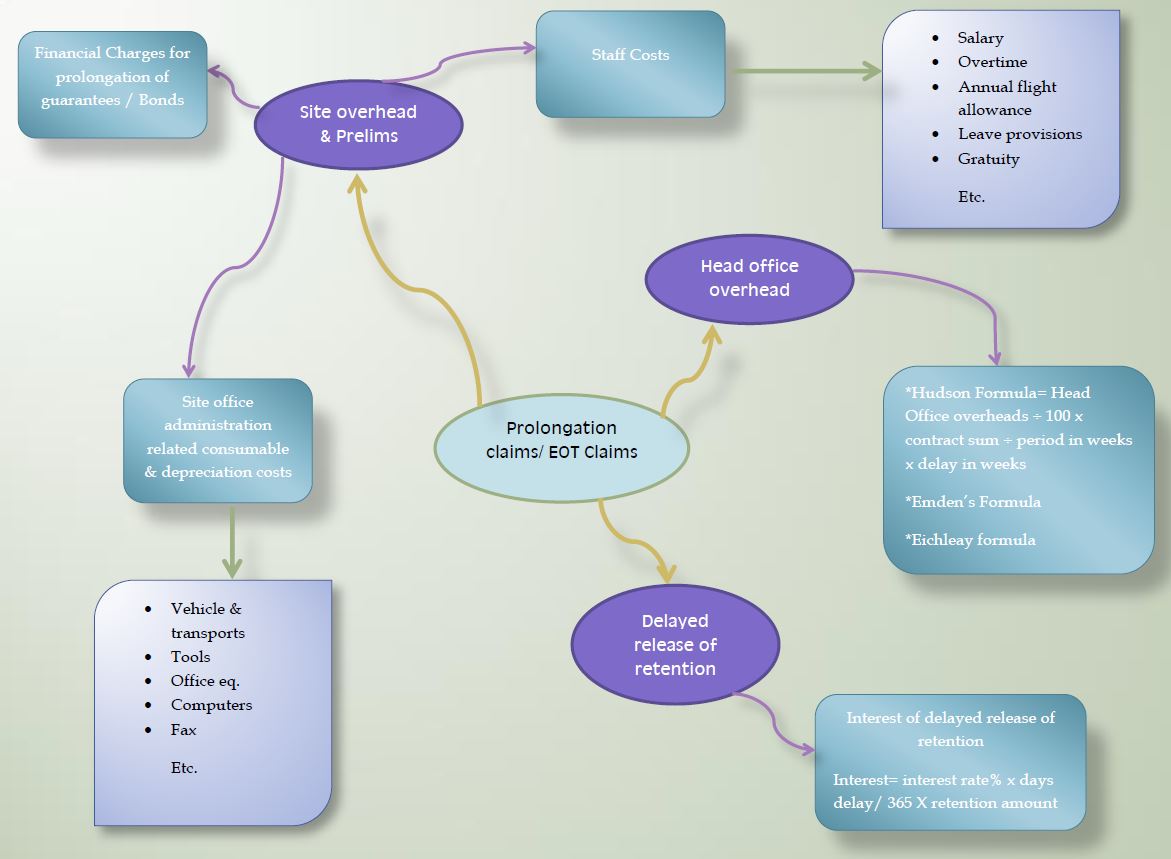How to prepare a claim for an extension of time

|
Contents |
[edit] Introduction
Construction contracts generally allow the construction period to be extended when there is a delay that is not the contractor's fault. This is described as an extension of time (EOT).
When it becomes reasonably apparent that there is, or that there is likely to be, a delay that could merit an extension of time, the contractor gives written notice to the contract administrator identifying the relevant event that has caused the delay, requesting the extension of time, presenting the reasons, and referencing the contract clause that allows the request. This letter is then assessed by the contract administrator (perhaps with input from the consultant team) before approval or rejection. If it is approved, the letter is given a written answer, and a change order is issued.
Sometimes, contracts may require the submission of requests within a specific time, otherwise, they can be rejected.
For more information, see Extension of time - approval letter example.
Proving delay and/or disruption can be a complicated and time-consuming process, and the quality of the information provided and the records available are often the key to successful claims. The claim should adequately establish both causation and liability, as well as the extent of the damages/disruption experienced by the contractor as a direct result of the delay.
To be able to do this effectively, the contractor should produce an accurate baseline programme before work begins, for progress to be monitored. The programme should show the planned productivity rates for the different work activities and appropriate benchmarks. As construction projects are naturally dynamic and subject to change, the programme should be continually updated and revised to reflect the current project conditions. This can enable the contractor to determine what effect a delay is likely to have on their ability to complete activities, making it easier to prepare their claim.
All events and issues which either cause, appear to cause, or have the potential to cause delay should be recorded by the contractor, including:
- When the event occurred.
- Why it occurred.
- The tasks that it affected and the reasons why.
- The resources that it required.
- A list of the affected activities from the schedule.
- Any other activities that were carried out, either on- or off-site, as a result.
- Sketches, photographs and plans.
- Details of actions taken by the contractor to avoid or minimise delays.
- Alternative solutions and/or a proposed recovery plan.
- Communications between the construction team relating to possible delays.
It is important that this is done at the time, as recording the causes of details of a delay retrospectively is often very difficult and time-consuming.
All costs which are associated with delay events should also be recorded wherever possible. Demonstrating a causal link between an event and subsequently incurred costs will make it more likely the claim will be approved.
The submitted claim should be concise, accurate and as clear as possible. It should explain the delay event and the sequence of events surrounding it, all of which should be cross-referenced to records, i.e. the programme. Retrospective delay analysis should be avoided if possible and used with caution if necessary.
Claim requests should also consider the following:
- Working days are different from calendar days.
- The reissuing of insurances and other bonds to cover extended periods.
- Summer days tend to be longer and more productive than winter days.
- Whether the extension of time being requested will be sufficient to cover all delays.
- The nature of the proposed changes and their ramifications.
- Once an extension of time has been approved, no additional time will be granted for the same item.
- Only one claim is necessary for a continuing delay.
[edit] Delay analysis methods
It is essential to analyse and present the exact impact due to the delay events. Delay analysis methods are used to analyse and present these impacts. The most popular delay analysis methods are:
- Impacted as-planned.
- Collapsed as-built.
- As-planned vs as-built.
- Time slice windows analysis.
- Time impact analysis.
- Longest path analysis.
[edit] What the contractor is entitled to claim
The contractor is entitled to claim the following essential costs:
- Site office costs.
- Site overheads.
- Head office overheads.
- Finance and insurance-related costs.
[edit] Related articles on Designing Buildings
- Acceleration of construction works.
- Change order.
- Common refusals of extensions of time.
- Compensation event.
- Contract administrator.
- Contract claims.
- Delay damages.
- Extension of time.
- Extension of time - approval letter example.
- Practical completion.
- Project programme.
- Time certainty.
- Time Risk Allowance TRA.
- Variations.
[edit] References
- Quantity Surveyor. (2019). Quick Guide to extension of time claims (EOT Claims) · Quantity Surveyor. [online] Available at: https://quantitysurveyor.blog/2019/10/26/quick-guide-to-extension-of-time-claims-eot-claims/ [Accessed 29 Oct. 2019].
Featured articles and news
The UK's Modern Industrial Strategy: A 10 year plan
Previous consultation criticism, current key elements and general support with some persisting reservations.
Building Safety Regulator reforms
New roles, new staff and a new fast track service pave the way for a single construction regulator.
Architectural Technologist CPDs and Communications
CIAT CPD… and how you can do it!
Cooling centres and cool spaces
Managing extreme heat in cities by directing the public to places for heat stress relief and water sources.
Winter gardens: A brief history and warm variations
Extending the season with glass in different forms and terms.
Restoring Great Yarmouth's Winter Gardens
Transforming one of the least sustainable constructions imaginable.
Construction Skills Mission Board launch sector drive
Newly formed government and industry collaboration set strategy for recruiting an additional 100,000 construction workers a year.
New Architects Code comes into effect in September 2025
ARB Architects Code of Conduct and Practice available with ongoing consultation regarding guidance.
Welsh Skills Body (Medr) launches ambitious plan
The new skills body brings together funding and regulation of tertiary education and research for the devolved nation.
Paul Gandy FCIOB announced as next CIOB President
Former Tilbury Douglas CEO takes helm.
UK Infrastructure: A 10 Year Strategy. In brief with reactions
With the National Infrastructure and Service Transformation Authority (NISTA).
Ebenezer Howard: inventor of the garden city. Book review.
The Grenfell Tower fire, eight years on
A time to pause and reflect as Dubai tower block fire reported just before anniversary.
Airtightness Topic Guide BSRIA TG 27/2025
Explaining the basics of airtightness, what it is, why it's important, when it's required and how it's carried out.
Construction contract awards hit lowest point of 2025
Plummeting for second consecutive month, intensifying concerns for housing and infrastructure goals.
Understanding Mental Health in the Built Environment 2025
Examining the state of mental health in construction, shedding light on levels of stress, anxiety and depression.
The benefits of engaging with insulation manufacturers
When considering ground floor constructions.
Lighting Industry endorses Blueprint for Electrification
The Lighting Industry Association fully supports the ECA Blueprint as a timely, urgent call to action.
























